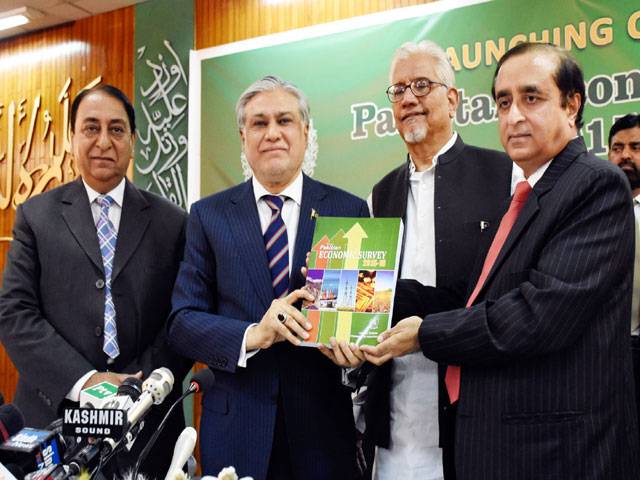ISLAMABAD - Following its previous two years tradition, the government has once again missed the GDP growth target during outgoing financial year 2015-2016, mainly due to the dismal performance of agriculture sector.
The GDP growth remained at 4.7 percent, missing the target by a wide margin of 0.8 percent.
“The government could not achieve the GDP growth target of 5.5 percent due to the low cotton production that eroded 0.5 percent growth,” said Finance Minister Ishaq Dar while addressing the launch of Economic Survey 2015-2016 along with his economic team.
The minister informed that the fiscal deficit during the nine-month period has remained 3.4 percent as opposed to 3.8 percent of the corresponding period last year.
Inflation was expected to remain below 3 percent. He claimed that unemployment rate has come down to 5.9 percent in the year 2015 from 6 percent of the previous year of 2014. Poverty rate has also come down as estimated on both old and new methodology.
The agriculture sector showed negative growth of 0.19 percent; however, the industrial sector grew by 6.8 percent against the target of 6.4 percent, and service sector successfully met its 5.7 percent growth target, as per the provisional estimate.
Commenting on the fall of exports, which have gone down to $18.18 billion (10MFY16), Dar said the quantity had gone up overall. However, the decrease in commodity and oil prices meant the return has been low.
The finance minister vowed that next budget would be growth oriented, which will create job opportunities and reduce poverty.
He said that government would announce a relief package for the agriculture sector in the budget.
He also hinted that government could also give incentives to the exporters in budget to boost the country’s exports that are on the declining side from more than one year.
Dar has also announced that Pakistan would not enter into new IMF programme after existing loan agreement to be completed in September this year.
“There is no intension of the government to take IMF loan, as Pakistan has more than four months import bill”, he said and added that the country would complete the ongoing IMF programme for the first time in history.
The minister informed that Federal Board of Revenue (FBR) and Swiss authorities would hold a meeting this month regarding exchange of information for bringing back $200 billion to the country.
Pakistan is expected to get membership of Organization for Economic Cooperation and Development (OECD’s) global forum that would ensure exchange of information regarding tax evasion, he added.
Explaining the poor performance of agriculture sector, he said cotton production dropped from 13.96 million bales last year to 10.07 million bales this year. Rice production slightly decreased to 6.81 million tonnes this year from 7 million tonnes last year. However, wheat production marginally increased from 25.09 million tonnes last year to 25.48 million tonnes this year.
“The government has downward revised the GDP growth target from 6.2 to 5.7 percent for the next fiscal year due to the dismal performance of the agriculture sector”, said economic wizard of the PML-N.
However, Ishaq Dar said that other sectors have performed well during outgoing financial year.
Industrial growth recorded 6.8 percent as against 4.81pc of the previous year. Large-scale manufacturing registered growth of 4.61pc as against 3.29pc of the last year. Automobile, fertilisers, leather products, rubber products, cement and chemicals industries recorded massive growths this year.
He went on say that electricity generation and gas distribution has showed growth of 12.18 percent as compared to last year’s growth of 11.98pc. Construction sector registered 13.10 percent growth during this year as against last year’s growth of 6.24pc.
“The country’s foreign exchange reserves have achieved new record of 21.6 billion dollars on 30th of May this year,” said the finance minister and added that reserves were only $7.6 billion in February 2014.
Dar said exports have gone down to $18.18 billion during ten months and so have the imports, which decreased by 4.6 percent to $32.73 billion during July-April of 2015-2016 from $34.32 billion of the corresponding months of the last year. The current account deficit has recorded at 0.6 percent of the GDP, he added.
“Worker remittances enhanced to $16.03 billion during July-April from $15.24 billion of the same period last year,” he said and vowed to achieve $19 billion target by the end of June 2016.
The foreign direct investment has shown growth of 5.4 percent to $1.02 billion during July-April from $960 million of the previous year. Around $518 million investment came in the power sector and $235 million in oil and gas sector. He said rupee-dollar parity is stable and per capita income stood at 1,560.7 dollar.
The minister said government would achieve the fiscal deficit target of 4.3 percent of the GDP and revenue collection target of Rs3,103 billion by the end of June 2016. Fiscal deficit during the nine-month period has remained 3.4 percent as opposed to 3.8 percent in the last year.
According to the Survey, total investment has reached to Rs4,502 billion as compared to Rs4,256 billion last year, showing 5.78 percent growth. Investment to GDP ratio reached to 15.21 percent in FY 2016.
Fixed investment have increased to Rs4,028 billion as compared to Rs3,816 billion last year, it has recorded growth of 5.57 percent and fixed investment as percentage of GDP is recorded at 13.61 percent.
Private investment recorded 3.71 percent growth and private investment as percentage of GDP reached to 9.79 percent. Whereas public investment grew by 10.63 percent and as percentage of GDP it increased from 3.72 percent to 3.82 percent, which is an indicator that government expenditure strategy is development oriented.
National savings increased to 14.6 percent of GDP against 14.5 percent last year.






